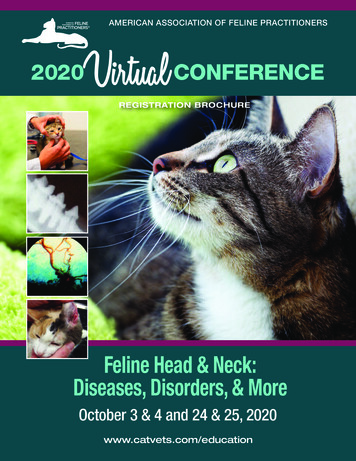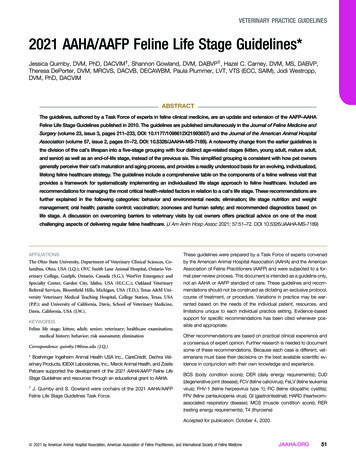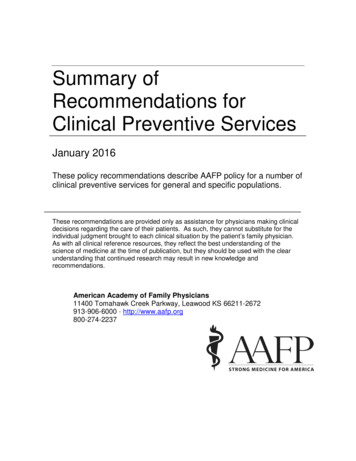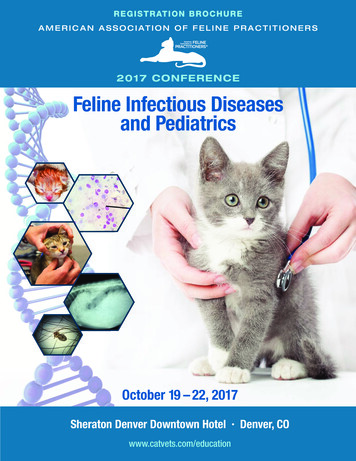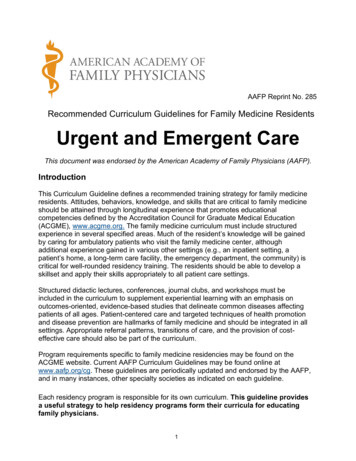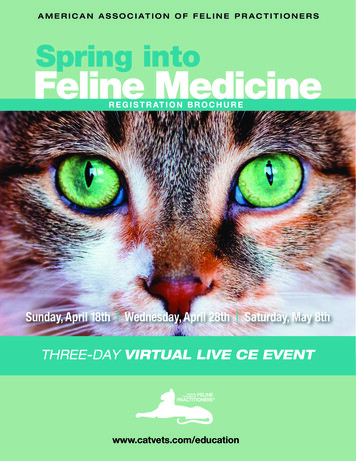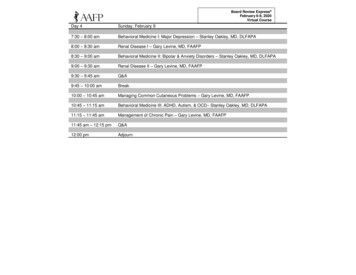
Transcription
FELINE BEHAVIORGUIDELINESFROM THE AMERICAN ASSOCIATION OF FELINE PRACTITIONERSAAFP gratefully acknowledges the generous support ofHill’s Pet Nutrition. Without the finances and other resourceswhich Hill’s supplied, this project could not have been completed. 2004 American Association of Feline Practitioners. All rights reserved.
AcknowledgementsThe AAFP Feline Behavior Guidelines report was also reviewed and approved by the FelinePractice Guidelines Committee of the American Association of Feline Practitioners and theAmerican Association of Feline Practitioners Board of Directors.Behavior Guidelines CommitteeHelen Tuzio, DVM, DABVP, Feline PracticeForest Hills Cat Hospital, Glendale, NYThomas Elston, DVM, DABVP, Feline PracticeThe Cat Hospital, Tustin, CAJames Richards, DVM, Director,Cornell Feline Health Center College of Veterinary Medicine, Cornell University, Ithaca, NYLorraine Jarboe, DVM, DABVP, Feline PracticeOlney-Sandy Springs Veterinary Hospital, Sandy Springs, MDSandra Kudrak, DVM, DABVP, Feline PracticeCommunity Animal Hospital, Poughkeepsie, NYThese guidelines were approved by the American Association of Feline Practitioners (AAFP) Board in December 2004 and areoffered by the AAFP for use only as a template; each veterinarian needs to adapt the recommendations to fit each situation.The AAFP expressly disclaims any warranties or guarantees expressed or implied and will not be liable for any damages ofany kind in connection with the material, information, techniques or procedures set forth in these guidelines.2
Panel MembersKaren L. Overall, MA, VMD, PhD, DACVB, ABSCertified Applied Animal Behaviorist, Panel Co-ChairResearch Associate, Psychiatry Department, Universityof Pennsylvania, School of Medicine; Philadelphia,PAIlona Rodan, DVM, DABVP, Feline Practice,Panel Co-ChairCat Care Clinic, Madison, WIBonnie V. Beaver, DVM, MS, DACVBCollege of Veterinary Medicine and BiomedicalScience; Texas A&M University; College Station, TXHazel Carney, DVM, MS, DABVP,Canine and Feline PracticeIdaho Veterinary Specialists; Four Rivers Feline SpecialTreatment Center, Garden City, ID and Ontario, ORSharon Crowell-Davis, DVM, PhD, DACVBDepartment of Anatomy and Radiology, University ofGeorgia, Athens, GANicole Hird, VMD, DABVP, Feline PracticeNorthwest Animal Hospital, Columbus, OHSandra Kudrak, DVM, DABVP, Feline PracticeCommunity Animal Hospital, Poughkeepsie, NYElaine Wexler-Mitchell, DVM, DABVP, Feline PracticeThe Cat Care Clinic, Orange, CALiterature SearchNicole Hird, VMD, DABVP, Feline PracticeNorthwest Animal Hospital, Columbus, OHExternal ReviewersMerry Crimi, DVMGladstone Veterinary Clinic, Milwaukie, ORTerry Curtis, DVM, MS, DACVBUniversity of Florida, Gainesville, FLSteve DaleAABC (Association of Animal Behavior Consultants),Tribune Media Services/WGN Radio, Host ofSyndicated Animal Planet Radio, Chicago, ILGary Landsberg, DVM, DACVBDoncaster Animal Clinic, Thornhill, ON, CanadaSusan Little, DVM, DABVPFeline Practice, Bytown Cat Hospital, Ottawa, CanadaMandy Miller, DVM, DABVPFeline Practice; Cat Care Clinic, Madison, WIMichael Paul, DVMMAGPI Consulting, Anguilla, BWISheldon Rubin, DVMBlum Animal Hospital, Chicago, ILRonald Schultz, PhD, DACVIMProfessor, School of Veterinary Medicine University of Wisconsin,Madison, WIKersti Seksel, DVM, BVSc (Hons) MRCVS MA (Hons) FACVSc(Animal Behavior), DACVBSeaforth Veterinary Hospital, Sydney, AustraliaKendal Sheperd, BVSc, MRCVS,Fineden, Northants, UKLink Welborn, DVM, DABVPTampa, FLAlice Wolf, DVM, DACVIM, DABVP, Feline PracticeCollege of Veterinary Medicine, Texas A&M University, CollegePresenterSteven Zicker, DVM, MS, PhD, DACVIM, DACVNHills Pet Nutrition, Inc., Topeka, KS3
CONTENTSI. Introduction .6II. The importance of feline behavior .7medicine in veterinary practiceIII. Preventive behavioral medicine .8IV. Understanding normal behavior.9Understanding normal behavior helps .9prevent problemsUnderstanding normal social behavior and .9communication can help prevent aggressionCat communication.11V. Aggression .13Preventing aggression towards humans.13Predatory behavior .13Inter-cat aggression.13VI. Understanding normal elimination .15behaviorVII. Scratching .16VIII. Feeding and ingestive behavior .17Preventing feeding problems .17IX. Learning in cats.19X. Preventive behavioral medicine at the .19veterinary clinicPre-adoption counseling .19Pleasant veterinary visits for cats.20XI. Kitten classes.23XII. Preventing harmful stress in cats.25prevents behavior problemsExamples of harmful stress.25Common indicators of feline stress, .25anxiety, or fear4
Preparation for life .25Protection from fear and stress .26Promotion of well-being.26XIII. Environmental enrichment .27XIV. Aging and behavioral changes.28XV. Principles of treatment and .29treatment modalitiesPrinciples of behavior treatment .29Medication .30How to administer medication.31When to refer .31For more information .35XVI. Summary .35XVII. Client Handouts .37Introducing a new cat into a household .37with already existing catsLitter box care to prevent or treat.38elimination problemsHow to prevent cats from scratching in .39undesired areasFeeding tips to prevent obesity in your cat.40How to help your cat have pleasant .41veterinary visitsEnvironmental enrichment enhances .42the quality of life for your cat5
I. INTRODUCTIONThe veterinary profession has the privilege and responsibility of caring for both animals and people. The benefits of living with a pet are now well recognized. By preventing and treating behavioral problems, we havethe opportunity to protect and strengthen the human-pet-veterinary bond and increase the quality of life forboth pets and pet lovers. The goal of the American Association of Feline Practitioners (AAFP) Feline BehaviorGuidelines is to support veterinarians by providing practical information and client educational materials tosuccessfully incorporate feline behavioral medicine into every practice that offers feline healthcare.Veterinarians have a great opportunity to save pets’lives by recognizing that behavioral medicine is asimportant as any other field of veterinary medicine,and can routinely be incorporated into each veterinaryvisit. Because most veterinarians never received education in veterinary school about feline behavior, and donot have the time and resources to study all the latestresearch and develop behavior protocols, the panelistshave worked to develop a concise, updated and “userfriendly” document that can be easily implemented.The guidelines include the following information: Emphasis is on prevention, from pre-adoption or thefirst veterinary visit, through senior life. Preventingbehavior problems should be an important part of totalwellness care. A list of behavior questions intended forinclusion in the medical history questions used at eachappointment is provided to aid in early detection andintervention of behavior problems. An outline is provided for guidance regarding how tocreate realistic expectations about living with a cat. Thiswill encourage cat owners to provide positive outlets toallow normal behavior, but in ways that clients will consider acceptable. Several of the appendices can be used for both prevention and treatment and can be made into clienthandouts; these will delegate client education to theveterinary support team and be used to facilitate theveterinarian’s role in client education.6 A developmental table specifying home and veterinarycare needed at different stages of life is included. Thiscan serve as an excellent poster or client informationhandout to help clients understand their responsibilities for home and veterinary care. Detailed information on behavior and environmentalenrichment is included to help prevent many of themost common behavior problems. Suggestions regarding prevention and treatment ofobesity, the most common consequence of domestication of cats, are provided. To help veterinarians better handle routine behaviorconcerns (eg, inappropriate elimination) a rational firstapproach to the problems seen day-to-day is included. Behavior counseling and treatment, including behaviormodification and environmental enrichment, are discussed in detail. For cats needing medical treatment,important drug information including dosing andtapering of medication is provided. Information onwhere to refer if needed is also provided. Information is provided that will promote comprehensive, state-of-the-art, holistic care that incorporatesboth the physical and psychological well-being of ourfeline patients. These guidelines will help veterinarians raise clientawareness that they should turn to the veterinary profession for advice regarding behavior, just as they dowith any medical concerns.
II. THE IMPORTANCE OF FELINE BEHAVIOR MEDICINEIN VETERINARY PRACTICEDespite continued advances in feline healthcare, behavior problems are still the most common cause of euthanasia in pet cats.1 Behaviorproblems, including normal cat behavior thatclients consider unacceptable, cause decreasedquality of life for cats and their owners.Behavior problems often lead to family stress,inappropriate punishment of pets, destructionof the bond between people and their pets, andrelinquishment and euthanasia. Most pets surrendered to shelters had been evaluated by aveterinarian in the year prior to relinquishment.2-4 Unresolved behavior problems causeveterinarians to annually lose approximately15% of their client base.5Patients, clients, and veterinary teams allbenefit from incorporating behavior servicesinto veterinary practices. Cats benefit byincreased quality and length of life, anenriched environment, and respectful, understanding relationships. The psychological benefits to clients of living with a beloved petinclude companionship, a feeling of beingneeded, and less depression.6,a The physicalbenefits include decreased blood pressure,reduced chance of a second heart attack, anddecreased triglyceride concentrations.7-11Children who live and work with pets gainincreased self-esteem.12There is evidence for an association betweenpet behavior and the level of owner attachment.13 A positive human-animal bond meansthat clients will seek more regular and extensive healthcare throughout their cats’ lives,which benefits pets, clients, and veterinary professionals alike. Veterinary practices that incorporate behavior wellness attract clients whoseek a high level of care for the pets they cherish. Veterinary professionals benefit by maintaining a positive relationship with pets andclients and improved job satisfaction. A positive veterinary-client bond results in clientswho are more likely to turn to the veterinaryhospital with pet concerns and recommendthe veterinary team to friends and acquaintances.The belief that behavior is too time-consuming to generate profit within the practice isa myth. Client education can be facilitated atall wellness appointments by giving client education handouts and reviewing them withclients. Teaching staff and clients how toimprove experiences for the cat at the veterinary clinic also improves patient behavior.Fewer staff, less time, and fewer resources areneeded to work with well-behaved patients.Positive experiences during veterinary visitsalso decrease stress and potential injury forcats, clients, and veterinary team members.Finally, educating veterinary team membersand allowing them to educate clients aboutprevention of behavior problems has thepotential to increase their job satisfaction,reduce staff stress and turnover, and allow veterinarians to use their time more effectively.Saving an animal’s life through preventionor treatment of a behavior problem can be asrewarding as saving a life through medical orsurgical procedures. Preventive behavior medicine belongs in every veterinary hospital and itis easy to integrate into practice. Incorporatingbehavior medicine into practice is a win-winsituation for all concerned.7
III. PREVENTIVE BEHAVIORAL MEDICINEVeterinary medicine comprises both the physical andpsychological well being of our patients. In cats, physicalillness and pain are most often recognized on the basis of anon-specific change in behavior. Knowing this helps clientsand veterinarians detect disease and discomfort and monitor efficacy of pain management. The veterinarian’sresponsibility is to relieve suffering, whether it is relatedto physical or emotional pain. We can support cat owners by making them aware of the need to contact theveterinary hospital not only for physical health but alsoas soon as they see indications of anxiety, fear, or behavior that they consider to be unacceptable or differentfrom their cat’s normal behavior.At routine examinations, clients may not tell us thatthe kitten bites, or that the cat “misses the box occasionally” unless we specifically ask those questions. Clientsoften think that the cat is acting “out of spite” or “gettingback at them” and are unaware that the veterinary profession can help with these problems. They may even beembarrassed to discuss such incidents and how they aredealing with them. It is important that we change thesemisconceptions. If behavior questions are not asked,clients will not know that the information is important,especially if they are unfamiliar with normal cat behavior. Conducting a behavior assessment at every veterinaryvisit is important for prevention and early detection ofbehavior-related as well as medical problems (Appendix1). Behavior assessments also encourage clients to consult with their veterinarian about their behavior concerns.The behavior history and medical examination arecritical to an accurate diagnosis. A comprehensive history, which includes a behavior assessment, physicalexamination, and diagnostic testing is needed to differ-entiate between behavior-related and systemic conditions. For example, a cat that is urinating inappropriately may have any number of conditions that are associated with that behavior, including feline lower urinarytract disease (interstitial cystitis) and arthritis, that makeit difficult to get into the litter box. Conversely, a cat withanorexia and lethargy may have an underlying medicalproblem or may simply be stressed by changes in itsenvironment. In other situations, the psychological wellbeing of the cat may have been harmed to the point thatpsychological effects are causing systemic disease.Appendix 1: Behavioral AssessmentQuestions to Ask at Every Veterinary VisitWhen obtaining a history, encourage early detection or prevention of behavior problems by asking the following questions: Does your cat urinate or defecate outside of the box? Does your cat spray? (Spraying occurs when a cat backs up toa vertical surface, kneads his or her feet, and flicks the tail tipwhile projecting urine.) Does your cat show signs of aggression to people, includinghissing, biting, or scratching? To any specific family members? To strangers? Does your cat exhibit any fearful behaviors that concern you? Does your cat show any destructive behaviors, such asscratching or chewing objects in the home? Does your cat have any problematic interactions with othercats or pets in the household? Has there been any change in your cat’s behavior or disposition? Do you need any further information regarding your cat’sbehavior?The behavioral history and medical examination are critical to anaccurate diagnosis. Comprehensive histories, which include a behavioral assessment; physical examinations; and diagnostic testing areneeded to differentiate between behavioral and systemic conditions.For example, a cat that is inappropriately urinating may have anynumber of conditions that are associated with this behavior, includingfeline lower urinary tract disease/interstitial cystitis, or arthritis thatmakes it difficult to get into the litter box. Or, a cat that presents withanorexia and lethargy may have an underlying medical problem, ormay simply be stressed by changes in its environment. The psychological well-being of the patient may be harmed to the point that it is alsocausing systemic disease.8
IV. UNDERSTANDING NORMAL BEHAVIORUnderstanding normal behavior helps prevent problems—Many behavior concerns expressed by clientsinvolve normal cat behavior that the client finds unacceptable. Educating clients about normal feline social andelimination behaviors, communication, and developmentalstages provides clients with realistic expectations. If we helpclients understand normal cat communication they caninteract with and react more appropriately to their cat,reducing the chance of aggression and injury.Understanding feline social and physical needs helpsclients provide a better, more stimulating environment,and reduces the chances of inappropriate elimination andscratching on surfaces other than scratching posts.Without understanding what is normal, veterinarianscannot diagnose what is abnormal. It is important todetermine whether the behavior is a normal behavior forthe cat that the owner finds unacceptable, a truly abnormal behavior for the cat, or an inappropriate behaviorthat the client has inadvertently taught or reinforced inthe cat.Understanding normal social behavior and communication can help prevent aggression—Research over thelast 2 decades has disproved the popular misconceptionthat cats live as solitary creatures. The domestic cat is asocial animal. However, the social organization of felinegroups is quite different from that of canine groups.Domestic cats are organized socially much like their earlyancestors. The feline social system is flexible, allowing catsto live alone or in groups of varying size (Figure 1).14 Freeliving domestic cats choose to live in social groups, calledcolonies, whenever sufficient food resources supportmultiple cats.15-27,b,cCats form social groups and have forms of communication that reflect their social behavior. Cats recognizeindividuals in their social group and have different interactions with different individuals (ie, preferred associaterelationships).28-30 Queens often engage in cooperativecare and rearing of their kittens. There is individual variation in the social behavior directed to other cats.31Colonies are fairly insular and strangers are generallynot welcome. Unfamiliar cats can be aggressively drivenaway. If a new cat repeatedly visits a group, it may even-tually be integrated into the group in a process thatrequires several weeks.21,c This is important to rememberwhen adopting new cats, especially adults. Integratingthem into an established group of cats should always bedone gradually.Within a group of cats, a social hierarchy can exist.When cats first establish their relationships, overt aggression (eg, hissing, chasing, swatting) may occur. Once therelationship is established, overt aggression is the exception as long as there are no environmental or physicalchanges. Social relationships can change throughout life.As with all social species, although the capacity to besocial is inborn, specific social skills that result in an individual cat being a successful member of a group arelearned.Socialization is the process that allows potential advantageous behavior changes as a result of exposure to novelsituations involving people, other animals, and new environments. The sensitive period is the term used for thedevelopmental stage when an animal has increased risk ofdeveloping fears and anxieties if the animal does not havethe opportunity to experience and learn from social andenvironmental stimuli.32 The primary socialization period of cats to people is from 3 to 9 weeks of age. Fear ofpeople is inhibited by exposure to people during thisperiod.33 Socialization that occurs early, especially beforeFigure 1 Two cats with typical feline social behavior.Courtesy of I. Rodan.9
Appendix 2. Developmental Periods in CatsThe following table has been developed by the panelists of the AAFP Feline Behavior Guidelines. It can serve as anexcellent poster, brochure, and/or client information handout to help clients have realistic expectations of their cats andunderstand their responsibilities for both home and veterinary irth–2 weeksNormal at this stageDiet entirely milk.Minimal social interaction.Stimulated by mother.Eyes open, walking by 14 days, can’t regulate body temperature,can’t groom self.To do’s for caregiversProvide high quality nutrition for queen or kitten formula.Minimal but gentle handling.None unless ill or failure to thrive.Provide warm, safe environment.If queen not present, rub perianal area with warm, wet towels tostimulate eliminations.EARLY SOCIALIZATION:3–8 weeksNormal at this stageBegins to eat solid food, gradually ceases milk consumptionSensitive period for social learning. Social play begins andincreases steadily. Learns many social skills.Develops control of bladder and bowel function. Begins to uselitter box.Object play begins and increases. Climbing and running begin.Capable of complex learning. Scratching and predatory behavior begin. Eye color changes. All baby teeth erupt. Can regulatebody temperature. Begins to groom self.To do’s for caregiversProvide high quality kitten food and fresh water daily.Frequent gentle handling and play with varied people includingmen, women, and supervised children. Expose to other cats andspecies while ensuring safety. Take kitten socialization classes ifavailable. Reward appropriate friendly behavior to humans andall other animals.Provide litter boxes with low sides for easy entry. Scoop litterboxes twice daily. Use unscented litter.Enrich environment including toys. Kitten-proof home. Exposeto novel objects and locations, Make the carrier a safe haven.Begin tooth brushing. Gently examine ears, teeth, nails. Groom.Provide scratching post. Begin training to harness and leash.Begin training to sit, come, etc.Ideally, first physical examination, deworm, FeLV/FIV test, andvaccines. Offer kitten socialization classes, Discuss behavior andnutrition.Never use hands and feet to play with kittens. This teaches yourkitten bad habits. Always use toys.10LATE SOCIALIZATION:9–16 weeksNormal at this stageEating solid food.Continues to learn social skills. Social play peaks. Social conflictover status may emerge.Continues using litter box.Vigorous exploration of the environment and climbing, beginsto lose baby teeth.To do’s for caregiversNo change.Continue social education. If had no previous social education,initiate slowly.May need larger litter box, (minimum box length 1.5 X cat’sbody length).Provide vertical space (e.g.,climbing structures). Continue basictraining.Serial physical examinations, vaccines and needed testing. Discussnutrition, behavior, spay or neuter. Offer kitten classes.Spay/neuter if not done. Repeat FeLV/FIV testing.Kittens that have not had adequate social experience during earlysocialization may have poor social skills and require extra effort toacquire good social skills.ADOLESCENCE17 weeks–1 yearNormal at this stageNo change.Sexual maturity if not sterilized. Social play lessens. Likely to besubordinate to larger adults but may challenge these cats forstatus.Spraying may occur, less likely if spayed or neutered.If allowed outdoor access, may wander farther and for longerperiods than before.To do’s for caregiversStart transition to high quality adult food at 6-8 months of age.Provide food puzzles and food toys.Continue to play with and reward friendly behavior. Contactveterinarian if serious conflicts arise.Reevaluate litter box size. Contact vet if spraying or inappropriate elimination occurs.Provide identification (e.g.,microchip or break-away collar andtag), especially if cat goes outdoors.
Spay or neuter if not previously done, discuss behavior andnutrition, repeat FeLV/FIV testing.If not spayed or neutered, your cat is more likely to urine markin the house, get into fights, and roam long distances. Femalecats that are not spayed can have unwanted kittens.ADULT1–6 yearsNormal at this stageMetabolic rate slows, may gain weight if diet and exercise notmonitored.Matures socially at approximately 2-3 years, personalitystrongly affected by genetics and early experience, social playdecreases but may continue given an available playmate.If intact male, urine odor becomes strong.Nothing.To do’s for caregiversReassess body condition and food intake every 3 months,encourage exercise.Continue to play with and reward friendly behavior.Reevaluate litter box size, contact vet if spraying or inappropriate elimination occurs.Rotate toys for self play, replace equipment and supplies suchas beds and litter boxes as needed.Annual examination. Vaccines and testing as recommended byveterinarian. Behavior problems are best treated early. Contactyour veterinarian if any behavior problems arise. Obesity carriesthe same health risks as it does in humans. Depending on coatand body condition, extra grooming may be needed.ADULT7 years and olderNormal at this stageChanges in appetite can occurDecreased activity may lead to decreased social interactionTo do’s for caregiversMonitor appetite and water intake. Contact vet if increases ordecreases.Continue social interaction—even if lower activity level iswarrantedContact veterinarian if elimination concerns occur or persistPhysical examination every 6 months. CBC, chemistry panel,UA, T4 every 6-12 months. Discuss behavior and nutrition.Interaction with younger cats may encourage activity, butextremely active young cats may be incompatible. Extra grooming may be needed, depending on body condition and coat.Medical problems increase with age and may present as behaviorchanges. Contact your veterinarian if changes occur.9 weeks of age, results in an increase in the kitten’swillingness to approach and be held by people, whichpersists into adulthood.34 Animals derive the benefitsof socialization when quite young (2 to 5 weeks of agein kittens) and exposure to humans may help teachthe animal how to learn from new stimuli throughoutlife. Unless animals have been prevented from experiencing typical stimuli, they usually retain some plasticity (ability to recover) throughout life, from havingexperienced some socialization.35If cats are excluded from interactions with andhandling by humans from 2 to 9 weeks of age, theirrisk of interacting poorly with humans in later life isincreased.36,37 Social learning occurs for many weeksafter that period, with social play peaking at approximately 3 months of age. An appendix (Appendix 2)describing developmental periods in cats has beendeveloped by the panelists of the AAFP FelineBehavior Guidelines. It can serve as an excellentposter, brochure, or client information handout tohelp clients have realistic expectations of their catsand understand their responsibilities for both homeand veterinary care.Genetic variables affect some aspects of temperament. For example, the offspring of bold fathers tendto be bolder than those of timid fathers; the offspringof friendly fathers tend to be quicker to approach,touch, and rub people.38,39 Veterinarians shouldinform cat breeders about the importance of selectingfor positive behavior traits and exposing kittens topeople during the sensitive period. A breed can benefit or be damaged by the degree to which cat breedersfollow this practice.Cat communication—Cats communicate throughvisual, tactile, olfactory, and auditory means. Visualsignaling includes body posture (Figure 2); tail, ear,and head position; and willingness to make eye contact (Figure 3). Tactile communication includes rubbing against others, including people; grooming; andnose-touching, which is used as a greeting. Auditorycommunication includes purring, which occurs primarily during contact with another individual. Thetrill (or chirrup) and meow are used as greeting calls.Because cats have such a keen sense of smell, olfactory communication is very important. Olfactory communication in the form of fecal or urine marking orspraying is often—but not always—normal behaviorthat clients find unacceptable.11
B2Figure 2 Illustrations of body posturesof cats. Notice that in the series fromA0B0 to A3B0, the cat becomes moreoffensive, whereas the cat becomesmore defensive in the series from A0B0to A0B3. A3B3 represents a cat withdefensive and offensive behaviors.A0B0 represents a calm cat. A3B0 represents the most aggressive cat in anoffensive, assertive sense; this is a catclients will want to watch in situationsinvolving profound inter-cat aggression or unprovoked aggression againsthumans (from Overall63 [used withpermission, adapted from Leyhausen P.Cat behavior: the predatory and socialbehavior of domestic and wild cats.Garland STPM Press: New York,1979]).Figure 3 Illustrations
Science; Texas A&M University; College Station, TX Hazel Carney, DVM, MS, DABVP, Canine and Feline Practice Idaho Veterinary Specialists; Four Rivers Feline Special Treatment Center, Garden City, ID and Ontario, OR Sharon Crowell-Davis, DVM, PhD, DACVB Department of Anatomy and Radiology, University of Georgia, Athens, GA
